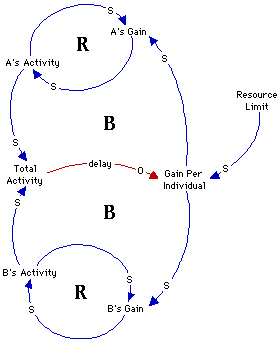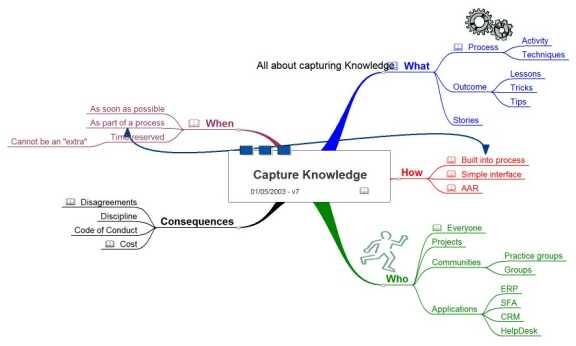There is a growing category of software tools designed to help you think better. Whether they help depends both on how you think and on why you think (i.e. whether you’re analyzing or imagining). Probably the best known thinking tool is Peter Senge’s systems thinking methodology. Basically cause-and-effect diagrams, they help turn negative reinforcing actions (vicious cycles) into positive ones (virtuous cycles). Here’s an illustration of the tragedy of the commons that is leading Bush to want to privatize everything, in systems thinking, from Outsights :
 You can buy Stella and ithink systems thinking software. I used this process to diagram the positive reinforcement of the 17 Projects in my How to Save the World proposal, and again in my analysis of depression . A second category of thinking tools might be defined as deconstructing tools. They take an idea or an objective and decompose it into its elements or aspects. Here’s an example of its use by Matt Mower to analyze the process of knowledge capture, using MindManager software:  There are many other tools that help you organize your thoughts, and hence at least indirectly think better. These include critical path and GANTT charts, and a variety of scheduling, system design and project management tools. There are software versions of many of these tools. Some bloggers have developed tools that work in connection with their blogs to help them find relevant information and inspiration. Here’s AugustDiva’s links for thinking . I think it’s a great improvement over blogrolls. How about right-brain, creative processes? Creative thinking gurus like De Bono and Michalko use models and exercises like Six Thinking Hats and Thinkertoys to stimulate the imagination, and perhaps remove blockages from creative thinking. It’s a matter of opinion whether the creative process lends itself to processes (and hence software tools) as rigorous as those for the analytical processes. What do you think? Do you use any of these tools, and do they actually help you think better? |
Navigation
Collapsniks
Albert Bates (US)
Andrew Nikiforuk (CA)
Brutus (US)
Carolyn Baker (US)*
Catherine Ingram (US)
Chris Hedges (US)
Dahr Jamail (US)
Dean Spillane-Walker (US)*
Derrick Jensen (US)
Dougald & Paul (IE/SE)*
Erik Michaels (US)
Gail Tverberg (US)
Guy McPherson (US)
Honest Sorcerer
Janaia & Robin (US)*
Jem Bendell (UK)
Mari Werner
Michael Dowd (US)*
Nate Hagens (US)
Paul Heft (US)*
Post Carbon Inst. (US)
Resilience (US)
Richard Heinberg (US)
Robert Jensen (US)
Roy Scranton (US)
Sam Mitchell (US)
Tim Morgan (UK)
Tim Watkins (UK)
Umair Haque (UK)
William Rees (CA)
XrayMike (AU)
Radical Non-Duality
Tony Parsons
Jim Newman
Tim Cliss
Andreas Müller
Kenneth Madden
Emerson Lim
Nancy Neithercut
Rosemarijn Roes
Frank McCaughey
Clare Cherikoff
Ere Parek, Izzy Cloke, Zabi AmaniEssential Reading
Archive by Category
My Bio, Contact Info, Signature Posts
About the Author (2023)
My Circles
E-mail me
--- My Best 200 Posts, 2003-22 by category, from newest to oldest ---
Collapse Watch:
Hope — On the Balance of Probabilities
The Caste War for the Dregs
Recuperation, Accommodation, Resilience
How Do We Teach the Critical Skills
Collapse Not Apocalypse
Effective Activism
'Making Sense of the World' Reading List
Notes From the Rising Dark
What is Exponential Decay
Collapse: Slowly Then Suddenly
Slouching Towards Bethlehem
Making Sense of Who We Are
What Would Net-Zero Emissions Look Like?
Post Collapse with Michael Dowd (video)
Why Economic Collapse Will Precede Climate Collapse
Being Adaptable: A Reminder List
A Culture of Fear
What Will It Take?
A Future Without Us
Dean Walker Interview (video)
The Mushroom at the End of the World
What Would It Take To Live Sustainably?
The New Political Map (Poster)
Beyond Belief
Complexity and Collapse
Requiem for a Species
Civilization Disease
What a Desolated Earth Looks Like
If We Had a Better Story...
Giving Up on Environmentalism
The Hard Part is Finding People Who Care
Going Vegan
The Dark & Gathering Sameness of the World
The End of Philosophy
A Short History of Progress
The Boiling Frog
Our Culture / Ourselves:
A CoVid-19 Recap
What It Means to be Human
A Culture Built on Wrong Models
Understanding Conservatives
Our Unique Capacity for Hatred
Not Meant to Govern Each Other
The Humanist Trap
Credulous
Amazing What People Get Used To
My Reluctant Misanthropy
The Dawn of Everything
Species Shame
Why Misinformation Doesn't Work
The Lab-Leak Hypothesis
The Right to Die
CoVid-19: Go for Zero
Pollard's Laws
On Caste
The Process of Self-Organization
The Tragic Spread of Misinformation
A Better Way to Work
The Needs of the Moment
Ask Yourself This
What to Believe Now?
Rogue Primate
Conversation & Silence
The Language of Our Eyes
True Story
May I Ask a Question?
Cultural Acedia: When We Can No Longer Care
Useless Advice
Several Short Sentences About Learning
Why I Don't Want to Hear Your Story
A Harvest of Myths
The Qualities of a Great Story
The Trouble With Stories
A Model of Identity & Community
Not Ready to Do What's Needed
A Culture of Dependence
So What's Next
Ten Things to Do When You're Feeling Hopeless
No Use to the World Broken
Living in Another World
Does Language Restrict What We Can Think?
The Value of Conversation Manifesto Nobody Knows Anything
If I Only Had 37 Days
The Only Life We Know
A Long Way Down
No Noble Savages
Figments of Reality
Too Far Ahead
Learning From Nature
The Rogue Animal
How the World Really Works:
Making Sense of Scents
An Age of Wonder
The Truth About Ukraine
Navigating Complexity
The Supply Chain Problem
The Promise of Dialogue
Too Dumb to Take Care of Ourselves
Extinction Capitalism
Homeless
Republicans Slide Into Fascism
All the Things I Was Wrong About
Several Short Sentences About Sharks
How Change Happens
What's the Best Possible Outcome?
The Perpetual Growth Machine
We Make Zero
How Long We've Been Around (graphic)
If You Wanted to Sabotage the Elections
Collective Intelligence & Complexity
Ten Things I Wish I'd Learned Earlier
The Problem With Systems
Against Hope (Video)
The Admission of Necessary Ignorance
Several Short Sentences About Jellyfish
Loren Eiseley, in Verse
A Synopsis of 'Finding the Sweet Spot'
Learning from Indigenous Cultures
The Gift Economy
The Job of the Media
The Wal-Mart Dilemma
The Illusion of the Separate Self, and Free Will:
No Free Will, No Freedom
The Other Side of 'No Me'
This Body Takes Me For a Walk
The Only One Who Really Knew Me
No Free Will — Fightin' Words
The Paradox of the Self
A Radical Non-Duality FAQ
What We Think We Know
Bark Bark Bark Bark Bark Bark Bark
Healing From Ourselves
The Entanglement Hypothesis
Nothing Needs to Happen
Nothing to Say About This
What I Wanted to Believe
A Continuous Reassemblage of Meaning
No Choice But to Misbehave
What's Apparently Happening
A Different Kind of Animal
Happy Now?
This Creature
Did Early Humans Have Selves?
Nothing On Offer Here
Even Simpler and More Hopeless Than That
Glimpses
How Our Bodies Sense the World
Fragments
What Happens in Vagus
We Have No Choice
Never Comfortable in the Skin of Self
Letting Go of the Story of Me
All There Is, Is This
A Theory of No Mind
Creative Works:
Mindful Wanderings (Reflections) (Archive)
A Prayer to No One
Frogs' Hollow (Short Story)
We Do What We Do (Poem)
Negative Assertions (Poem)
Reminder (Short Story)
A Canadian Sorry (Satire)
Under No Illusions (Short Story)
The Ever-Stranger (Poem)
The Fortune Teller (Short Story)
Non-Duality Dude (Play)
Your Self: An Owner's Manual (Satire)
All the Things I Thought I Knew (Short Story)
On the Shoulders of Giants (Short Story)
Improv (Poem)
Calling the Cage Freedom (Short Story)
Rune (Poem)
Only This (Poem)
The Other Extinction (Short Story)
Invisible (Poem)
Disruption (Short Story)
A Thought-Less Experiment (Poem)
Speaking Grosbeak (Short Story)
The Only Way There (Short Story)
The Wild Man (Short Story)
Flywheel (Short Story)
The Opposite of Presence (Satire)
How to Make Love Last (Poem)
The Horses' Bodies (Poem)
Enough (Lament)
Distracted (Short Story)
Worse, Still (Poem)
Conjurer (Satire)
A Conversation (Short Story)
Farewell to Albion (Poem)
My Other Sites





I just don’t get diagrams. For some reason they have never worked for me. If it is a simple bar graph I do ok. But for me it is like a guessing game which I hate.Maybe I need remedial diagram 101..
Everyone learns differently. That’s why some people (mostly guys) like maps and others (mostly women) like sequential directions.
Thinking tools confuse me most of the time. Then I realize why: I didn’t have any thoughts of my own to work out to begin with.
Men like maps? hehe… hmmmm… ok. The ones in my life have prided themselves in being able to find anything without a map. Actually, I love maps. I used to study them as a kid. Which is weird when I think about it. I need to consider this.
Don’t tell any of my clients, or at least don’t tell the really big conservative clients, but I use a system that is really very similar to Mindmanager from what I can tell from your diagram (in that it accounts for but follows consequences, but it also accounts for antecedents). This system uses a fixed set of bi-directional pathways between a fixed-set of nodes in a network, where each of the nodes is itself expressible recursively in the same decompositional map.In this design system, the who and what are applied by how through the for the purpose of the consequence, where the consequence is itself a secondary design system that is the effective what. Applying the same chain to the what leads to the way the system reacts over time, like a meta-how/when, and that leading to a consequence chain that is itself the seed of the future projects that will obsolesce this one.it sounds complex, but this four-part systemic thinking is mnemonically evident in the organization of the pathways so the whole thing is reasonably easy to remember and simple enough to apply that it doesn’t really require software and works pretty well off 5×3 flash cards.It’s called The Tarot.
I’m late coming to this, but I love this stuff. Anyway, inspiration is great software, mostly used in education circles and not too expensive. Do you know of any open source mindmapping software tools?
Excellent post. Systems thinking software is the future. Thanks for the link to Stella and ithink. I will likely be buying Stella for my own systems thinking analysis..All the best.